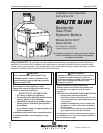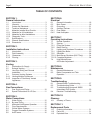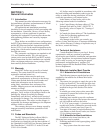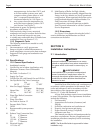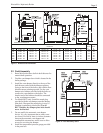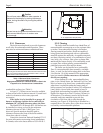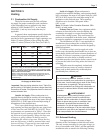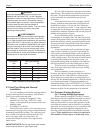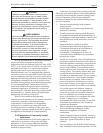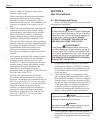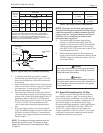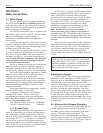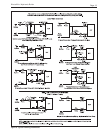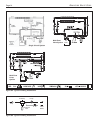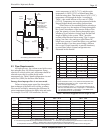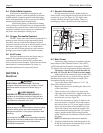
Brute Mini Hydronic Boiler
Page 9
WARNING
Operation of appliances with a blocked common
vent may lead to serious injury or death. Safety
devices must be implemented to prevent blocked
common vent operation. If safe operation of all
appliances connected to a common vent cannot be
assured, including prevention of spillage of flue
gasses into living spaces, common venting should
not be applied, and appliances should each be
vented separately.
AVERTISSEMENT
Le fonctionnement des appareils avec un système
d’évacuation bloqué peut provoquer des blessures
graves, voire la mort. Des dispositifs de sécurité
doivent être installés pour éviter le blocage des
systèmes d’évacuation. Si le fonctionnement de
tous les appareils connectés à un système
d’évacuation commun ne peut pas être assuré, y
compris la prévention de la dispersion des gaz
toxiques dans les espaces habités, on ne devrait
pas installer un système d’évacuation commun et
chaque appareil devrait être ventilé séparément.
It is for this reason that, in addition to following
proper vent sizing, construction and safety
requirements from the National Fuel Gas Code, ANSI
Z223.1 or in Canada, from CSA B149.1 as well as all
applicable local codes, it is required that installers
provide some means to prevent operation with a
blocked common vent. It is suggested that a blocked
vent safety system be employed such that if the switch
from one appliance trips due to excessive stack spill or
backpressure indicating a blocked vent condition, that
all appliances attached to the vent be locked out and
prevented from operating. As an additional precaution,
it is recommended that a Carbon Monoxide (CO)
alarm be installed in all enclosed spaces containing
combustion appliances. If assistance is required in
determining how a blocked vent safety system should
be connected to a product, please call Applications
Engineering (see back cover for info).
Refer to the installation and operating
instructions on all appliances to be common vented for
instructions, warnings, restrictions and safety
requirements. If safe operation of all appliances
connected to a common vent cannot be assured,
including prevention of spillage of flue gasses into
living spaces, common venting should not be applied,
and appliances should each be vented separately.
3.4.2 Inspection of Commonly Vented
Appliances
If the instrumentation of this boiler replaces an
older boiler in a common vent system with other
appliances, or if you remove additional appliances
from the common vent, all the appliances must be
checked for proper venting.
At the time of removal of an existing boiler, the
following steps shall be followed with each appliance
remaining connected to the common venting system
placed in operation, while the other appliances
remaining connected to the common venting system
are not in operation.
1. Seal any unused openings in the common
venting system.
Sceller toutes les ouvertures non utilisées du
système d’évacuation.
2. Visually inspect the venting system for proper
size and horizontal pitch and determine there is
no blockage or restriction, leakage, corrosion and
other deficiencies which could cause an unsafe
condition.
Inspecter de façon visuelle le système
d’évacuation pour déterminer la grosseur et
l’inclinaison horizontale qui conviennent et
s’assurer que le système est exampt
d’obstruction, d’étranglement, de fuite, de
corrosion et autres défaillances qui pourraient
présenter des risques.
3. Insofar as it is practical, close all building doors
and windows and all doors between the space in
which the appliances remaining connected to the
common venting system are located and other
spaces of the building. Turn on clothes dryers
and any appliance not connected to the common
venting system. Turn on any exhaust fans, such
as range hoods and bathroom exhausts, so they
will operate at maximum speed. Do not operate a
summer exhaust fan. Close fireplace dampers.
Dans la mesure du possible, fermer toutes les
portes et les fenêtres du bâtiment et toutes les
portes entre l’espace où les appareils toujours
raccordés au système d’évacuation sont installés
et les autres espaces du bùtiment. Mettre en
marche les sécheuses, tous les appareils non
raccordés au systéme d’évacuation commun et
tous les ventilateurs d’extraction comme les
hottes de cuisinière et les ventilateurs des salles
de bain. S’assurer que ces ventilateurs
fonctionnent à la vitesse maximale. Ne pas faire
fonctionner les ventilateurs d’été. Fermer les
registres des cheminées.
4. Place in operation the appliance being inspected.
Follow the lighting instructions. Adjust
thermostat so appliance will operate
continuously.
Mettre l’appareil inspecté en marche. Suivre les
instructions d’allumage. Régler le thermostat de
façon que l’appareil fonctionne de façon
continue.
5. Test for spillage at the draft hood relief opening
after 5 minutes of main burner operation. Use the



